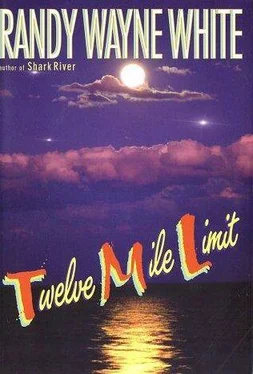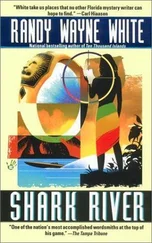Randy White - Twelve Mile Limit
Здесь есть возможность читать онлайн «Randy White - Twelve Mile Limit» весь текст электронной книги совершенно бесплатно (целиком полную версию без сокращений). В некоторых случаях можно слушать аудио, скачать через торрент в формате fb2 и присутствует краткое содержание. Жанр: Триллер, на английском языке. Описание произведения, (предисловие) а так же отзывы посетителей доступны на портале библиотеки ЛибКат.
- Название:Twelve Mile Limit
- Автор:
- Жанр:
- Год:неизвестен
- ISBN:нет данных
- Рейтинг книги:4 / 5. Голосов: 1
-
Избранное:Добавить в избранное
- Отзывы:
-
Ваша оценка:
- 80
- 1
- 2
- 3
- 4
- 5
Twelve Mile Limit: краткое содержание, описание и аннотация
Предлагаем к чтению аннотацию, описание, краткое содержание или предисловие (зависит от того, что написал сам автор книги «Twelve Mile Limit»). Если вы не нашли необходимую информацию о книге — напишите в комментариях, мы постараемся отыскать её.
Twelve Mile Limit — читать онлайн бесплатно полную книгу (весь текст) целиком
Ниже представлен текст книги, разбитый по страницам. Система сохранения места последней прочитанной страницы, позволяет с удобством читать онлайн бесплатно книгу «Twelve Mile Limit», без необходимости каждый раз заново искать на чём Вы остановились. Поставьте закладку, и сможете в любой момент перейти на страницу, на которой закончили чтение.
Интервал:
Закладка:
I almost allowed him to lure me off the subject and back into our old debate on parapsychology, ghosts, the whole mystical question. I’d like to believe such things happen. Who wouldn’t? If certain people really can foresee the future or read the minds of others, it adds substantial weight to the proposition that there is symmetry and spiritual purpose to the human experience. I would like to believe that, but I don’t.
I’ve heard Tomlinson’s so-called proofs often enough, but I have yet to see proof myself of mystical, extrasensory powers. Tomlinson has an eerie ability to read people and quickly perceive what few others can-that, I don’t argue. I suspect he does it by interpreting body language, voice intonations, who knows, though he’s very good at it. But could he really know what happened the night the Seminole Wind sank without being there? That I did not believe and would not accept.
I took the pilot chart off the deck and folded it open beside my plate. “So if you perceived all that through meditation, tell me how it was. What happened to the three of them after they got split up from Amelia? Are they still alive?”
Tomlinson smiled patiently and tugged his scraggly blond hair back with his left hand, letting the question hang there before he answered, “Marion, sarcasm is your least attractive quality. You resort to it so rarely, I sometimes forget.”
I was cleaning my thick glasses, wanting to see and understand all the little symbols on the chart. I pulled the oil lamp closer as I said, “I’m sorry. So I withdraw the offensive tone, but the question’s the same. What do you think happened? Why didn’t we find them?”
“What I think is, one of the reasons is right there in front of you. Actually the main reason. Look at the current arrows. It’s all right there on the chart.”
Pilot charts are superb tools for the blue-water voyager or the gunk-holing cruiser. They give a lot more information than the much more commonly used U.S. government or NOAA nautical charts. Published by the Defense Mapping Agency, their aim is to help the mariner select the fastest and safest routing for any offshore passage at any time of the year. The charts provide information on weather conditions for very specific areas. They note prevailing winds and calms, average wave heights, typical barometric pressure, average currents, air and water temperatures, and recommended routes.
This pilot chart was for the Gulf of Mexico, Campeche, Mexico to Cuba to New Orleans and Florida, the entire, massive basin dotted with symbols and navigational data. The chart consisted of twelve pages, one for each month of the year, and I had it open to the month of November. I found Marco Island, found the little crosshatched egg-shaped icon at 25 degrees 21 minutes 60 seconds north latitude and 82 degrees 31.97 minutes west longitude: the wreck of the Baja California.
As I studied the chart, noting the feathered arrows that marked prevailing winds and the serpentine arrows that indicated ocean currents and tidal currents, Tomlinson said, “When the Seminole Wind sank, all the detritus drifted southwest. The life jackets, the empty tanks, everything we found. So it’s very natural to assume that three swimmers wearing inflated vests would also drift southwest.”
I was nodding, enjoying the food, enjoying the concise data on the chart, the way they accurately distilled the wild ocean into an orderly and predictable rendering of numbers, graphs, directional arrows. I said, “It’s more than an assumption. All of the data-marking buoys the Coast Guard dropped-what? There were half a dozen or so of them? DMBs-they all drifted southwest. Covered five or six miles every twenty-four hours, which…” I paused. “Now that I think about it, and this is the first time I’ve checked a pilot chart, that doesn’t seem right. It says here the prevailing ocean current runs at about two knots. Anything floating, adrift, should have covered at least thirty, maybe forty, miles in twenty-four hours.”
“Exactly. I was struck by that, too. The figures don’t seem to work out. I spent the afternoon holed-up in Mack’s office doing research on the computer, calling sailor buddies of mine, a couple of shrimp-boat captains who do a lot of dragging in that area. You ever seen a data-marking buoy?”
I had, but I let Tomlinson talk.
“They’re sealed canisters, about three feet long, flat on both ends, painted bright orange, and heavier on the bottom to make them float upright. There’s a GPS antenna on top. Self-locating data-marking buoys, that’s the official name. They send a signal directly to a satellite that tracks their movement. So it’s got to be accurate.”
I said, “Very accurate. Which is why I hadn’t stopped to question the math before. So why did the buoys drift so slowly?”
He stood, came around behind me, looking over my shoulder at the chart. Tomlinson has huge, bony hands with nails bitten down to the quick. Now he touched an index finger to the icon that represented the Baja California. “Okay, this is where they dropped the DMBs, right on the wreck site. All along this line. According to the chart, the prevailing winds are out of the northeast-and they were that night, blowing fifteen to twenty. Prevailing current moves east-southeast at about two knots. The wind was blowing slightly against the current, and that would have reduced the speed of drift. The DMBs covered only about six miles a day. So far, it’s just like the Coast Guard and all the rest of us figured.”
I said, “Three people wearing vests would have blown southwest with the wind, but slowed quite a bit by a current trying to push them to the east. Then that explains it. They would have traveled the same direction and at a similar speed as the buoys.”
Tomlinson said, “Not necessarily. Last night, I took this chart with me when I crawled into my bunk. Kept looking at it and looking at it. You know how when you look directly at a star too long, it disappears? I did that with the area around the Baja California. I just let it blur until it vanished, and that’s when the whole current system came into focus. I’m talking about for the entire Gulf of Mexico. Try it. Let your eyes go wide, imagine the current arrows are in red. Let them stand out and see what happens. The big picture is what you need to see.”
I looked at the chart momentarily, tried to let my eyes blur, but then shook my head. “My imagination isn’t that good. Save us both some time and just tell me what it is I’m supposed to see.”
“Okay, first thing you see is a big saltwater lake, more than a thousand miles wide between Florida and Mexico. The Gulf of Mexico.” He moved his finger down to Cuba. “The saltwater lake has only two openings. There’s a 20-mile-wide opening here between the Florida Keys and Cuba. There’s a 125-mile opening here between Cuba and the Yucatan Peninsula. Those are damn small openings for ocean currents to squeeze through. Take a garden hose, squeeze the end with your thumb, and the water speeds up. Like a jet.”
I said wryly, “I’m aware of that. It’s called the Venturi effect. Constrict flowing water or gas, and its velocity increases.”
“That’s precisely what happens in the Gulf. The arrows here tell the whole story. The equatorial current and the Guiana current come flowing into Cuba, get squeezed between Cuba and the Yucatan, then blast into the Gulf, directly toward Louisiana, the Mississippi River Delta country. The current’s so strong that it ricochets off the southern shallows and breaks into two great looping currents. Those currents break into a series of crazy spirals, smaller loops, like gyres.”
He began to tap the chart with his finger. “There’s one here… a gyre here… here. They’re all over the place. One side of the gyre flows more or less south, the other side flows more or less north. They’re like big, slow-motion whirlpools floating around out there at sea. Oval-shaped rivers that, in the fall and winter, flow at one, maybe even two knots, and faster in summer. Ultimately, most of them exit and gain speed at the stricture between Key West and Cuba.”
Читать дальшеИнтервал:
Закладка:
Похожие книги на «Twelve Mile Limit»
Представляем Вашему вниманию похожие книги на «Twelve Mile Limit» списком для выбора. Мы отобрали схожую по названию и смыслу литературу в надежде предоставить читателям больше вариантов отыскать новые, интересные, ещё непрочитанные произведения.
Обсуждение, отзывы о книге «Twelve Mile Limit» и просто собственные мнения читателей. Оставьте ваши комментарии, напишите, что Вы думаете о произведении, его смысле или главных героях. Укажите что конкретно понравилось, а что нет, и почему Вы так считаете.












